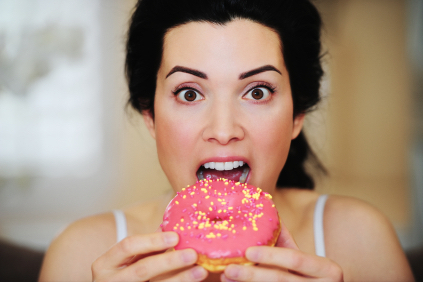 BY MARK HYMAN, MD
BY MARK HYMAN, MD
The average person gains 11 pounds for every diet they go on. Even worse, when they lose weight, they lose muscle and fat. When they regain weight, they gain back all fat. And since muscle burns seven times as many calories as fat, their metabolism is slower than when they started the diet. The cruel fact is that they then need even less calories to maintain their weight.
Haven’t you known someone who was very overweight and said they don’t eat that much? They may not be lying. They have just damaged their metabolism by yo-yo dieting.
The key to losing weight and keeping it off are two simple things. First, automatically reduce your appetite not by white knuckling it and starving yourself but fixing the out-of-whack hormones and brain chemistry that drive hunger and overeating.
The second is to automatically increase your metabolism so you burn more calories all day long. Unfortunately, most diets do the opposite – increase hunger and slow metabolism.
Here are the five reasons most diets fail and how to succeed.
- You use willpower instead of science to control your appetite
There is a science of hunger. Unfortunately, most diets (eating less) will trigger hunger. You can only hold your breath for so long. You can only starve yourself for so long. Powerful ancient mechanisms compensate and protect us from starvation (even if it is self induced). Our hunger dramatically increases, our cravings ramp up and our metabolism slows way down to conserve energy. Eating certain foods (low fat, higher carb or sugary foods) actually increases hunger and slows metabolism.
Success Principle: Appetite
- Eat enough to satisfy your appetite (but only real whole fresh food).
- Eat protein for breakfast and avoid eating 3 hours before bed.
- Compose your meals to balance blood sugar and lower insulin. Combine protein, fat and low-glycemic, non-starchy carbs (vegetables, fruit, small amounts (less than half a cup of grains and beans) at each meal. Fat and protein and fiber slow insulin spikes.
- You focus on calories (eating less and exercising more)
The mantra of calories in/calories out, of energy balance as the key to weight loss, is quickly entering the scientific dustbin. In my last blog on Automatic Weight Loss, I reviewed the science behind that fact that all calories are not created equally.
Some calories make you fat, some calories make you thin. What we now know is that any foods that spike insulin (sugar, flour and even excess grains, fruit and beans) trigger a shift in your metabolism. What does insulin do? It drives all the fuel in your blood from the food you just ate into your hungry fat cells (visceral or belly fat).
Then, your body thinks you are starving even though you just at a giant bagel or sucked down a Big Gulp. And remember, two things happen when your body thinks you are starving – you increase hunger and slow metabolism.
Have you ever eaten a big meal, then, an hour later, felt hungry again and needed to go raid the fridge or eat something sweet? That’s why.
Success Principles: Calories
- Focus on very low-glycemic foods as the staples of your diet. Nuts, seeds, chicken, fish, grass fed meats, low-glycemic veggies (greens, salad fixings, etc.)
- Use grains and beans sparingly (not more than a half cup once a day each).
- Use sugar– in very small doses. And all sugar is the same. If you have to ask “is ______ OK?” It isn’t.
- Don’t use artificial sweeteners– they trigger sweet receptors, hunger and slow metabolism leading to obesity and type 2 diabetes.
- You eat a low-fat diet
Most people still believe we should avoid egg yolks and that eating a low-fat diet will help them lose weight. The old idea that fat has 9 calories per gram and carbs 4 calories per gram led to the mistaken idea that if we cut out fat, we would lose weight.
Well, look what’s happened to America in the last 30 years, where low fat has been the rage and the method for weight loss. We are fatter than ever (70 percent of us are overweight), and now, 1 in 2 Americans has pre-diabetes or type 2 diabetes or what I like to call “diabesity.”
Harvard scientist Walter Willet reviewed all the science on low fat and weight loss and found that it is not eating fat that makes you fat but sugar. A recent study by David Jenkins found that a low-carb (26%), high-fat (43%) vegan diet was more effective for weight loss and reducing cardiovascular risk factors than a vegan low-fat diet. The high-fat group lost 4 more pounds and dropped their cholesterol 10 more points by eating high fat. They called it Eco-Atkins!
Other studies show that by eating more fat and less carbs you can increase your metabolism by 300 calories a day (eating the same total calories a day). That’s like getting the benefit of running for an hour a day without getting off the couch. You could call it “The Butt Diet.” Sit on your butt and lose 1 pound every 11 days.
Success Principles: Fat
- Don’t fear fat. It actually makes you feel full, speeds up your metabolism and helps you lose weight.
- Eat good fats at every meal.
- Eat vegetable fats, such as avocado, nuts, seeds, coconut butter or oil
- Eat clean animal fats (organic eggs with the yolk, chicken, grass-fed meats) and fish with omega 3 fats (sardines, herring, wild salmon, black cod).
- You have hidden reasons and need medical help
There are reasons beyond your diet or amount of exercise that affect your weight and metabolism. Your body is a system and many things affect metabolism. I have written about them in my books, The Blood Sugar Solution, or The Blood Sugar Solution 10-Day Detox Diet.
The biggest hidden causes of weight grain or resistance to weight loss are the things that cause inflammation. And inflammation from anything that triggers weight gain by worsening insulin resistance.
What causes inflammation?
Hidden food allergies or sensitivities. Gluten and dairy are the most common culprits. But don’t switch to gluten-free or dairy-free options. Gluten-free cakes and cookies are still cake and cookies. They are still very high in sugar and refined carbs and flours. Just try soy yogurt with the sweeteners. You wouldn’t eat it!
Gut Problems. The microbiome – the 100 trillion bacteria in your gut – play an enormous role in metabolism and health. If you have bad bugs (from eating refined, high-sugar, carb, low-fiber diet or taking antibiotics, acid blockers) they can either trigger inflammation or alter how your food is broken down and absorbed. Fecal transplants from a thin to an obese person will change their metabolism. What’s next? Poop transplants for weight loss. Maybe!
Toxins. Science has discovered that common environmental chemicals (pesticides, household cleaners, make up, pollution and heavy metals) can be “obesogens.” Chemicals that make you fat. In animal studies, giving rats a toxin caused weight gain even if they ate the same amount of calories and exercised the same.
Success Principles: Find Hidden Causes of Weight Gain
- Try an elimination diet. Not eliminating calories but getting rid of inflammatory foods. Start with gluten and dairy. 100 percent for 3 weeks.
- Fix your gut. Avoid gut-busting drugs (acid blockers, antibiotics and anti-inflammatories).
- Starve the bad bugs by eating a low-glycemic, low-fermentation (starch) diet. Take probiotics. See a Functional Medicine doctor to get help if you don’t success on your own.
- Detox your body and your life. Reduce exposure to environmental and common chemicals. See the resources at the Environmental Working Group to reduce exposures in skin-care products, household products and the food you eat (meat and veggies). And the NRDC resource for eating fish without mercury. Eat two cups of cruciferous veggies a day (broccoli family). You may need help from a Functional Medicine doctor to do a medically supervised detoxification program.
- You don’t have a plan.
Health is not something that happens to you. It is something you have to plan, like a vacation or your retirement! Most of us fail because we don’t “design our health.” We don’t set up the conditions for automatic success.
In my book The 10-Day Detox Diet, one of the days is focused on the principle of “Design.” How do you design your life so that you don’t have to think about doing the right thing? You create conditions for making it easy – have all the right foods in the house, the right ingredients all ready for your morning protein shake, creating an emergency travel food pack, having your plan for exercise for the week in advance.
Also, we find that doing things together makes them easier. At Saddleback Church, we got 15,000 people to lose 250,000 pounds in a year by having them do it together. Every body needs a buddy! Joining a group of people doing this in person or an online community or group makes it fun and makes it work. We have created online challenges where people have had profound success in redesigning their life for good.
Find what works for you but don’t expect health to happen. You have to plan for it!
Success Principles: Create a Plan
- Commit to designing your health. Do it weekly on Sundays!
- Create an emergency life pack of food.
- Join a community or get a buddy or a friend.
The science of health and weight loss is not a mystery. But old ideas die hard. If you look out for these five ways that diets fail and focus on the principles of success then you will build habits and practices that work. Health and weight loss are not a struggle. It’s not rocket science, just science!




